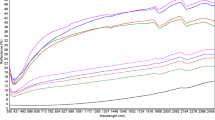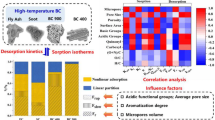Abstract
Purpose
The effects of black carbon (BC) on resistant desorption of organic pollutants in soil and sediment were evaluated to further understand the mechanisms for the resistant desorption and to find a more accurate desorption model which can improve risk assessment and management of ubiquitous soil/sediment contamination.
Materials and methods
A soil and sediment were used to create “combusted” soil/sediment with only BC and no other organic matter remaining by 375°C chemothermal oxidation (CTO-375) method. Polycyclic aromatic hydrocarbons (PAHs) including naphthalene and phenanthrene were used as sorbates, their sorption and desorption by the original soil/sediment (with organic matter and BC), and combusted soil/sediment (only BC) were examined.
Results and discussion
All sorption isotherms were fitted with linear model and Freundlich model. Sorption isotherms of naphthalene and phenanthrene on the original soil/sediment were almost linear (Freundlich coefficient n = 0.86, 1.00, 0.87, and 0.75), whereas the BC remaining after the soil/sediment combustion showed nonlinear (n = 0.70, 0.48, 0.56, and 0.55) and higher sorption (e.g., KOC = 1.36 × 104 with naphthalene equilibrium solution concentration of 0.001 mg l-1 for combusted soil, one order higher than that for the original sample accordingly). Desorption resistance was observed for both the original and combusted soil/sediment, and the resistant desorption from combusted soil/sediment was much stronger than that from original soil/sediment based on the quantification of desorption hysteresis with thermodynamic index of irreversibility (TII) values (TII = 0.73–0.88). A biphasic desorption isotherm can well describe the resistant desorption for all PAH-sorbent combinations.
Conclusions
The BC could have significant effect on desorption of PAHs from soil and sediment, the BC fraction in soils and sediments could be the predominant component responsible for desorption hysteresis. More accurate biphasic desorption models can be used to improve risk assessment and management of ubiquitous soils/sediments contamination by PAHs.




Similar content being viewed by others
References
Alexander M (2000) Aging, bioavailability, and overestimation of risk from environmental pollutants. Environ Sci Technol 34:4259–4265
Braida WJ, Pignatello JJ, Lu Y, Ravikovich PI, Neimark AV, Xing B (2003) Sorption hysteresis of benzene in charcoal particles. Environ Sci Technol 37:409–417
Bucheli TD, Gustafsson Ö (2000) Quantification of the soot–water distribution coefficient of PAHs provides mechanistic basis for enhanced sorption observations. Environ Sci Technol 34:5144–5151
Chai Y, Kochetkov A, Reible DD (2006) Desorption resistance of polycyclic aromatic hydrocarbons and duration of exposure. Environ Toxicol Chem 25:2827–2833
Chai Y, Qiu X, Davis JW, Budinsky RA Jr, Bartels MJ, Saghir SA (2007) Effects of black carbon and montmorillonite clay on multiphasic hexachlorobenzene desorption from sediments. Chemosphere 69:1204–1212
Chen B, Yuan M (2010) Enhanced sorption of polycyclic aromatic hydrocarbons by soil amended with biochar. J Soil Sediment 11:62–71
Chen W, Kan AT, Tomson MB (2000) Irreversible adsorption of chlorinated benzenes to natural sediments—implication for sediment quality criteria. Environ Sci Technol 34:385–392
Chen W, Kan AT, Newell CJ, Moore E, Tomson MB (2002) More realistic soil cleanup standards with dual-equilibrium desorption. Ground Water 40:153–164
Chen W, Hou L, Luo X, Zhu L (2009) Effects of chemical oxidation on sorption and desorption of PAHs in typical Chinese soils. Environ Pollut 157:1894–1903
Cheng X, Kan AT, Tomson MB (2004) Naphthalene adsorption and desorption from aqueous C60 fullerene. J Chem Eng Data 49:675–683
China Soil Scientific Database (2006) Institute of Soil Science, Chinese Academy of Sciences
Cornelissen G, Gustafsson Ö (2004) Sorption of phenanthrene to environmental black carbon in sediment with and without organic matter and native sorbates. Environ Sci Technol 38:148–155
Cornelissen G, Kukulska Z, Kalaitzidis S, Christanis K, Gustafsson Ö (2004) Relations between environmental black carbon sorption and geochemical sorbent characteristics. Environ Sci Technol 38:3632–3640
Cornelissen G, Gustafsson Ö, Bucheli TD, Jonker MTO, Koelmans AA, VanNoort PCM (2005) Extensive sorption of organic compounds to black carbon, coal, and kerogen in sediments and soils: mechanisms and consequences for distribution, bioaccumulation, and biodegradation. Environ Sci Technol 39:6881–6895
Duan L, Zhang N, Wang Y, Zhang C, Zhu L, Chen W (2008) Release of hexachlorocyclohexanes from historically and freshly contaminated soils in China: implications for fate and regulation. Environ Pollut 156:753–759
Ghosh U, Talley JW, Luthy RG (2001) Particle-scale investigation of PAH desorption kinetics and thermodynamics from sediment. Environ Sci Technol 35:3468–3475
Gustafsson O, Haghseta F, Chan C, Macfarlane J, Gschwend PM (1997) Quantification of the dilute sedimentary soot phase: implications for PAH speciation and bioavailability. Environ Sci Technol 31:203–209
Harris D, Horwáthb WR, Van Kessel C (2001) Acid fumigation of soils to remove carbonates prior to total organic carbon or Carbon-13 isotopic analysis. Soil Sci Soc Am J 65:1853–1856
Kan AT, Fu G, Hunter M, Chen W, Ward CH, Tomson MB (1998) Irreversible sorption of neutral hydrocarbons to sediments: experimental observations and model predictions. Environ Sci Technol 32:892–902
Koelmansa AA, Jonkerb MTO, Cornelissenc G, Buchelid TD, Noorte PCMV, Gustafsson Ö (2006) Black carbon: the reverse of its dark side. Chemosphere 63:365–377
Liu J, Zhang Y, Chen H, Zhao Y, Quan X (2009) Contribution of black carbon to nonlinearity of sorption and desorption of acetochlor on sediment. Front Environ Sci Eng China 3:69–74
Luthy RG, Aiken GR, Brusseau ML, Cunningham SD, Gschwend PM, Pignatello JJ, Reinhard M, Traina SJ, Walter J, Weber J, Westall JC (1997) Sequestration of hydrophobic organic contaminants by geosorbents. Environ Sci Technol 31:3341–3347
Oen AMP, Cornelissen G, Breedveld GD (2006) Relation between PAH and black carbon contents in size fractions of Norwegian harbor sediments. Environ Pollut 141:370–380
Pignatello JJ, Xing B (1996) Mechanisms of slow sorption of organic chemicals to natural particles. Environ Sci Technol 30:1–10
Pignatello JJ, Lu Y, LeBoeuf EJ, Huang W, Song J, Xing B (2006) Nonlinear and competitive sorption of apolar compounds in black carbon-free natural organic materials. J Environ Qual 35:1049–1059
Qi Y, Chen W (2010) Comparison of earthworm bioaccumulation between readily desorbable and desorption-resistant naphthalene: implications for biouptake routes. Environ Sci Technol 44:323–328
Rockne KJ, Shor LM, Young LY, Taghon GL, Kosson DS (2002) Distributed sequestration and release of PAHs in weathered sediment: the role of sediment structure and organic carbon properties. Environ Sci Technol 36:2636–2644
Sander M, Pignatello JJ (2007) On the reversibility of sorption to black carbon: distinguishing true hysteresis from artificial hysteresis caused by dilution of a competing adsorbate. Environ Sci Technol 41:843–849
Sander M, Lu Y, Pignatello JJ (2005) A thermodynamically based method to quantify true sorption hysteresis. J Environ Qual 34:1063–1072
Schwarzenbach RP, Gschwend PM, Imboden DM (2003) Environmental organic chemistry. Wiley Interscience, New York
Sobek A, Stamm N, Bucheli TD (2009) Sorption of phenyl urea herbicides to black carbon. Environ Sci Technol 43:8147–8152
Sun X, Ghosh U (2008) The effect of activated carbon on partitioning, desorption, and biouptake of native polychlorinated biphenyls in four freshwater sediments. Environ Toxicol Chem 27:2287–2295
Wang L, Niu J, Yang Z, Shen Z, Wang J (2008) Effects of carbonate and organic matter on sorption and desorption behavior of polycyclic aromatic hydrocarbons in the sediments from Yangtze River. J Hazard Mater 154:811–817
Watanabe N, Schwartz E, Scow KM, Young TM (2005) Relating desorption and biodegradation of phenanthrene to SOM structure characterized by quantitative pyrolysis GC-MS. Environ Sci Technol 39:6170–6181
Wu W, Sun H (2010) Sorption–desorption hysteresis of phenanthrene—effect of nanopores, solute concentration, and salinity. Chemosphere 81:961–967
Xiao B, Yu Z, Huang W, Song J, Peng P (2004) Black carbon and kerogen in soils and sediments: 2. Their roles in equilibrium sorption of less-polar organic pollutants. Environ Sci Technol 38:5842–5852
Xing B, Pignatello JJ (1997) Dual-mode sorption of low-polarity compounds in glassy poly(vinyl chloride) and soil organic matter. Environ Sci Technol 31:792–799
Yang W, Duan L, Zhang N, Zhang C, Shipley HJ, Kan AT, Tomson MB, Chen W (2008) Resistant desorption of hydrophobic organic contaminants in typical Chinese soils: implications for long-term fate and soil quality standards. Environ Toxicol Chem 27:165–172
Yang W, Zhang J, Zhang C, Zhu L, Chen W (2009) Sorption and resistant desorption of atrazine in typical Chinese soils. J Environ Qual 38:171–179
Zhang J, He M (2009) Predicted models for phenanthrene sorption nonlinearity and capacity based on different HA/BC ratios in sediments. J Colloid Interface Sci 337:338–344
Acknowledgments
This work was supported by Ministry of Science of Technology (grant 2009BAC60B01).The authors also would like to thank the United States National Science Foundation’s East Asian and Pacific Summer Institute for making this research possible.
Author information
Authors and Affiliations
Corresponding author
Additional information
Responsible Editor: Jan Schwarzbauer
Electronic supplementary material
Below is the link to the electronic supplementary material.
ESM 1
(DOCX 23.4 kb)
Rights and permissions
About this article
Cite this article
Yang, W., Lampert, D., Zhao, N. et al. Link between black carbon and resistant desorption of PAHs on soil and sediment. J Soils Sediments 12, 713–723 (2012). https://doi.org/10.1007/s11368-012-0494-0
Received:
Accepted:
Published:
Issue Date:
DOI: https://doi.org/10.1007/s11368-012-0494-0




